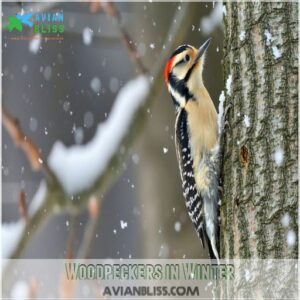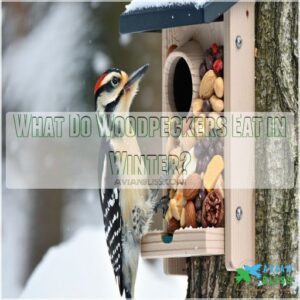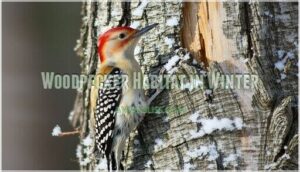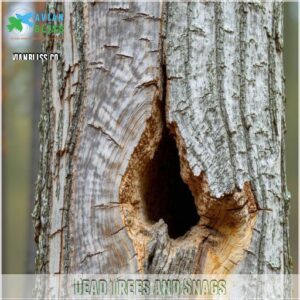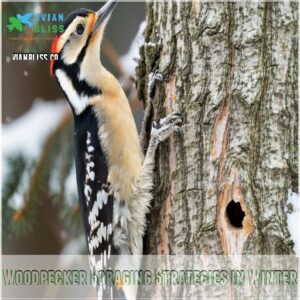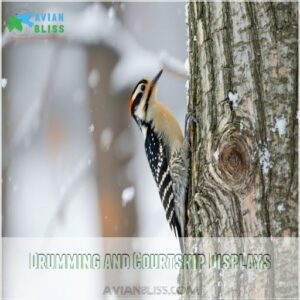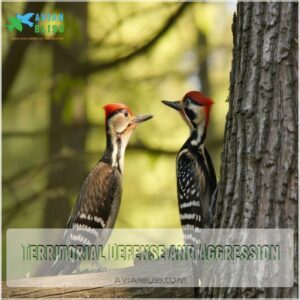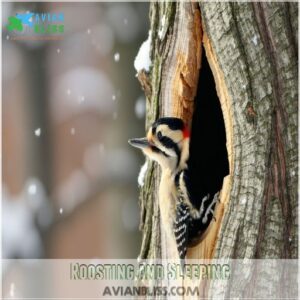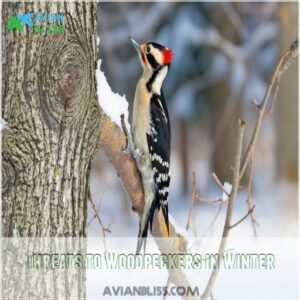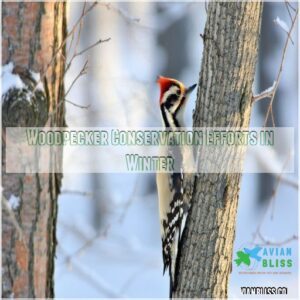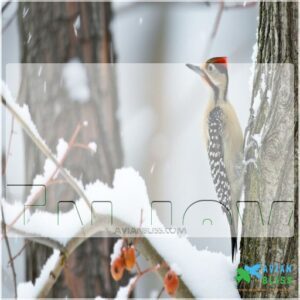This site is supported by our readers. We may earn a commission, at no cost to you, if you purchase through links.
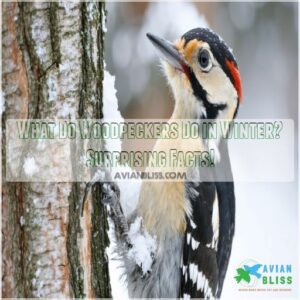
While some species migrate south, many stick around, drilling cozy winter homes in tree trunks and storing food like nuts and berries in bark crevices – nature’s version of a pantry.
They’ll switch from summer insects to winter fare like tree sap, suet, and cached seeds.
These resilient birds often join mixed-species flocks, creating social networks that help them spot food and stay safe from predators.
Their remarkable winter survival strategies showcase nature’s ingenious solutions to harsh conditions.
Table Of Contents
- Key Takeaways
- Woodpeckers in Winter
- What Do Woodpeckers Eat in Winter?
- Woodpecker Habitat in Winter
- How to Attract Woodpeckers in Winter
- Woodpecker Foraging Strategies in Winter
- Common Winter Woodpecker Behaviors
- Types of Woodpeckers in Winter
- Threats to Woodpeckers in Winter
- Woodpecker Conservation Efforts in Winter
- Enjoy
- Frequently Asked Questions (FAQs)
- What do pileated woodpeckers eat in winter?
- How do woodpeckers survive winter?
- Why do pileated woodpeckers migrate in winter?
- Why do woodpeckers roost in the winter?
- Are woodpeckers active in winter?
- Why do woodpeckers eat bare branches in winter?
- What is the Average Lifespan of a Woodpecker?
- How Often Do Woodpeckers Need to Find New Roosting Cavities?
- Do Woodpeckers Migrate in Flocks or Alone?
- Is There a Difference in Woodpecker Behavior in the Winter Versus the Summer?
- What Other Animals Use Woodpecker Roosting Cavities in the Winter?
- How do woodpeckers survive the winter?
- Should I feed woodpeckers in the winter?
- Do woodpeckers peck in the winter?
- Do woodpeckers come back to the same place every year?
- Do woodpeckers sleep in their nests every night?
- How long do woodpeckers stay in one territory?
- Can woodpeckers freeze to death in winter?
- Do woodpeckers mate and breed during winter?
- How do woodpeckers keep their beaks sharp?
- Conclusion
Key Takeaways
- You’ll find woodpeckers staying active in winter by drilling cozy homes in tree trunks and storing food like nuts and berries in bark crevices for later use.
- You can help woodpeckers thrive by offering suet feeders, maintaining water sources, and leaving dead trees standing as natural habitats.
- You’ll notice woodpeckers adapting their diet from summer insects to winter fare like tree sap, cached seeds, and suet from bird feeders.
- You’ll see woodpeckers joining mixed-species flocks in winter, which helps them spot food sources and stay protected from predators.
Woodpeckers in Winter
When winter rolls around, you might think woodpeckers are heading south, but many tough it out in colder climates.
They adapt with clever strategies like storing food and finding cozy shelters, making them true winter survival experts.
Migration Patterns
Woodpeckers’ winter tricks include mixing up their digs.
Think of it as their seasonal shuffle rather than a grand tour.
Here’s the scoop:
- Short Hops: Some make quick moves within their range.
- Habitat Shifts: Northern birds head southward.
- Lower Elevations: Western woodpeckers seek valley vibes.
- Stay Put: Others tough it out in nearby neighborhoods.
Winter survival, woodpecker style!
Food Storage and Caching
As winter sweeps in, you might wonder how woodpeckers manage their food.
These clever birds adopt caching strategies, stashing seeds, nuts, and even insects in tree crevices.
Imagine them as nature’s little stockpilers—squirreling away winter food stores like tiny pantry keepers, ensuring they’ve enough to munch on during the colder months.
This food hoarding highlights their survival instincts.
Flocking Behavior and Social Interactions
Even in winter, woodpeckers have a social side, engaging in fascinating flocking dynamics.
You might spot them communicating through distinct drumming and calls, establishing social hierarchies and territory defense.
While some prefer solitude, others mingle, adapting their interactions to seasonal changes.
Imagine them exchanging notes on prime feeding spots—it’s a lively community effort to survive the colder months.
Roosting and Shelter Seeking
Seeking warmth, woodpeckers excel at picking snug shelters for winter roosting.
From hollowed tree cavities to cozy nooks, their keen sense guarantees winter insulation and predator avoidance.
These adaptable birds, with their smart shelter adaptations, resemble nature’s own architects, effortlessly finding secure spots where they belong.
Picture it as selecting the perfect home, with woodpeckers like the Red-bellied Woodpecker often favoring woodlands and backyards; woodpecker behavior shines through their winter habitat choices.
Adaptations for Cold Weather
Finding a cozy roost is only half the battle; woodpeckers also need to stay warm!
They fluff their feathers for extra insulation, a natural puffy coat against the cold.
This helps them conserve energy for foraging.
Some species even store food, boosting their winter survival strategies.
Clever adaptations, right?
Their ability to find food and stay warm determines their winter success.
What Do Woodpeckers Eat in Winter?
As winter sets in, you might wonder what keeps woodpeckers’ bellies full when the insects seem to disappear.
Surprisingly, they shift their diet to include a tasty mix of seeds, nuts, suet, and even tree sap, ensuring they stay nourished until spring.
Insects and Invertebrates
Imagine woodpeckers pecking away at tree bark, hunting for the tiny treasures hidden inside.
Yep, insects and invertebrates are a big part of their winter diet.
To help these birds thrive, you can even provide supplemental winter woodpecker insects food sources.
These feathered foragers expertly snatch up a snack of ants and beetles, ensuring their winter survival.
It’s like a bug buffet, and their diverse menu supports population dynamics even in chilly months.
Seeds and Nuts
In terms of their winter diet, woodpeckers have a knack for seeds and nuts.
Imagine them as nature’s tiny stockpilers, practicing impressive caching behavior to keep their bellies full during chilly days.
Different species have unique preferences, foraging diligently to find their favorite food sources.
These little acorn-hunters rely on their keen sense of location memory to revisit their nut storage sites.
Suet and Bird Feeders
To attract a variety of birds, including woodpeckers, consider incorporating Alabama’s native flora into your yard, such as plants that provide berries, seeds, or nectar. Bringing woodpeckers to your backyard in winter is a cinch with suet and bird feeders.
These birds go nuts for suet cakes, packed with fat and protein that fuel their high energy needs.
Opt for large suet feeders with tail props; they accommodate the birds’ size comfortably.
Homemade or store-bought, suet becomes the winter woodpecker buffet of choice.
Tree Sap and Phloem
In winter, woodpeckers, like the persistent Sapsuckers, cleverly tap into tree sap using phloem feeding techniques.
Imagine this: they create sap wells, enabling them to enjoy the steady sap flow even as snow blankets the ground.
Here’s what woodpeckers do:
- Craft sap wells.
- Tap trees for food.
- Store food efficiently.
- Feed on phloem.
Fruits and Berries
Just as woodpeckers tap into trees for sap, they also have an eye for fruits and berries.
In winter, these little treats become a key part of their diet.
Think of berries as nature’s energy snacks, offering quick fuel.
Woodpeckers swoop through berry-laden bushes, relishing the abundance.
With a clever foraging strategy, they keep cozy and well-fed.
Woodpecker Habitat in Winter
You’ll find woodpeckers in various winter habitats, from sprawling forests and bustling suburban yards to even your own backyard!
Woodpeckers are adaptable birds and utilize dead trees for nesting and foraging, alongside water sources and areas with readily available food.
Forests and Woodlands
Woodpeckers aren’t just pecking around for food in forests and woodlands during winter—they’re embracing diversity!
These habitats offer a rich menu, from varied tree types to abundant understory plants.
With a healthy winter canopy providing shelter, woodpeckers find perfect spots for roosting and foraging.
Think of these lively spaces as nature’s all-you-can-eat buffet for our feathered friends.
Urban and Suburban Areas
From lively forests to the bustling urban sprawl, woodpeckers prove adaptable neighbors, where they often face challenges such as light pollution effects.
They’re not just tree-huggers; they thrive in suburban nooks, converting telephone poles into surprise nesting sites.
These birds find winter food sources in urban habitats, boldly pecking at fences and enjoying human impact without a fuss.
Providing them nesting sites means coexisting peacefully with nature’s feathered carpenters.
Backyard Feeders and Gardens
Amidst winter’s chill, your backyard can become a haven for woodpeckers with a sprinkle of preparation and a dash of creativity. Enhance your garden’s allure with:
- Planting native trees for natural habitats
- Attracting different species with diverse feeders, such as woodpecker feeders available online (specialized woodpecker feeders)
- Appealing feeder placement
- Crafty DIY suet recipes
- Bird-friendly landscaping choices
Each adds flavor to winter bird care.
Dead Trees and Snags
Think of dead trees and snags as the ultimate wildlife refuge.
They’re like the woodpecker’s cozy lodge, offering a snag habitat where bustling insect buffets and prime cavity nesting sites await.
Without these natural havens, roosting and shelter become dicey.
So, leaving snags standing is more than a decor choice; it’s providing a safe haven for woodpeckers during winter.
Water Sources and Riparian Habitats
Water sources are a lifeline for woodpeckers in winter.
These clever birds use riparian habitats not just for riverine foraging but for streamside nesting too.
Imagine them probing frozen banks for riparian insects!
Habitat restoration of these areas boosts their survival.
It’s like finding hidden treasure in icy conditions, ensuring their diet stays diverse and nutritious.
How to Attract Woodpeckers in Winter
If you want to make your winter garden the hangout spot for woodpeckers, start by offering suet and a variety of bird feeders.
Don’t forget to replicate the unique ecosystem found in Rocky Mountain habitats where woodpeckers thrive among aspen groves and Ponderosa pines. Don’t forget to keep water sources unfrozen and create a habitat that feels like home for our feathered friends by letting dead trees stand tall.
Offering Suet and Bird Feeders
Many woodpeckers appreciate a helping hand during winter’s chill.
Suet cakes, a tasty mix of beef fat and seeds, are a favorite.
You can find pre-made suet or whip up your own using simple suet cake recipes.
To attract various woodpecker species, including the Hairy Woodpecker and its habitat preferences that involve specific tree species and elevation adaptations. Proper feeder placement near trees helps attract various woodpecker species.
Offering high-calorie seeds like black oil sunflower seeds from a well-insulated birdhouse for winter helps fuel their energy needs. This winter bird feeding strategy boosts their foraging success.
Consider DIY feeders for a fun project!
Remember, suet is a key part of a woodpecker’s winter diet.
Providing Water Sources
When you’d like to welcome woodpeckers to your winter wonderland, make sure water sources are available. Even frozen times call for water:
- Install a heated birdbath to prevent ice.
- Refresh the water daily so it doesn’t freeze.
- Position baths near trees, offering safety as they take a sip. Watching them splash is pure joy!
Creating Woodpecker-Friendly Habitat
Setting up a woodpecker-friendly habitat in your winter yard can be like crafting a cozy retreat.
Think native tree planting to guarantee year-round roosting spots and food sources.
Position bird feeders strategically to support foraging habits while keeping them safe from predators.
Add water source tips for an extra touch of hospitality.
Create a welcoming space, and woodpeckers will feel right at home!
Leaving Dead Trees and Snags Standing
Think of your yard as a haven for woodpeckers by leaving dead trees and snags standing.
These natural structures are like condos for wildlife, offering perfect spots for roosting.
They enhance woodpecker habitat, support forest health, and underscore snag benefits and ecological importance.
This approach nurtures a sense of belonging and contributes greatly to the value of your local wildlife community.
Woodpecker Foraging Strategies in Winter
When winter rolls around, woodpeckers become quite the clever strategists, engaging in drumming and pecking to locate hidden insect meals beneath bark.
You might even catch them expertly probing and excavating, or stashing food away in tree crevices for a chilly day.
Drumming and Pecking
Drumming is like a woodpecker’s vibrant Morse code, communicating territory and potential mates during winter.
As pileated woodpeckers in winter primarily rely on mature forests with large trees for their winter range, their drumming also serves as a declaration of presence and a defense strategy against intruders.
This rhythmic pecking isn’t just noise; it’s a declaration of presence and a defense strategy against intruders.
As you watch these feathered carpenters, you’ll notice their pecking patterns—nature’s percussionists, pounding out a tune of survival and alerting others to their foraging grounds.
Probing and Excavating
Picture a woodpecker using its sharp beak as a built-in tool. Probing and excavating techniques transform tree bark into a treasure trove of insects. Here’s how they do it:
- Insect Extraction: Reach deep for hidden larvae.
- Drilling Techniques: Create cavities in dead wood where they can find food like winter woodpecker food.
- Bark Foraging: Search nooks and crannies.
- Woodpecker Beaks: Perfect for winter foraging.
Gleaning and Searching
Woodpeckers also employ gleaning, carefully searching bark surfaces for insects.
They use their sharp beaks to probe crevices and cracks, skillfully extracting hidden prey.
This careful searching is a key part of their winter foraging strategies, ensuring a steady supply of food.
Imagine them as tiny, feathered detectives, solving the mystery of where tasty bugs hide!
Their keen eyesight and precise movements make them incredibly efficient hunters.
They’re experts at finding hidden food sources throughout the winter months.
Caching and Retrieving
Caching food is like setting up a secret snack cupboard for woodpeckers.
They stash away treasures in hidden spots, hoping their bird-brained memory doesn’t fail them.
Winter caching behavior shows their skill in safe food storage and retrieval.
Their caching success rates aren’t perfect, but they often find just enough to keep their bellies full during chilly months.
Common Winter Woodpecker Behaviors
In winter, you’ll often find woodpeckers drumming away, not just for food, but to mark their territory and attract mates.
They also engage in social interactions, sometimes forming flocks for a little extra warmth and camaraderie during the colder months.
Drumming and Courtship Displays
In winter, drumming patterns aren’t just about noise; they’re the woodpecker’s mixtape for love.
These rhythmic beats woo mates and help in nest selection.
Picture a woodpecker dropping a beat, with its courtship displays echoing through frosty trees.
Their unique percussion also acts like a billboard, flaunting their territory while providing insight into woodpecker behavior and winter adaptations.
Territorial Defense and Aggression
During winter, woodpeckers aren’t just tapping tunes; they engage in drumming contests to mark territory boundaries.
Whether it’s about nesting disputes or food competition, these birds aren’t shy about showing aggression.
Picture them in a feathery face-off, asserting dominance over their patch.
These territorial defense antics aren’t just about survival—it’s how woodpeckers secure home in their chilly world.
Social Interactions and Flocking
While territorial defense is serious business, woodpeckers show social interactions and flocking for winter survival.
Picture a group of these birds as a lively family gathering, chatting through distinct drumming and calls.
Different species exhibit unique social hierarchies and communication methods, ensuring effective woodpecker survival.
Embracing flocking behavior helps them weather the cold months together.
Roosting and Sleeping
Woodpeckers know exactly how to catch some Z’s during winter.
Their sleep patterns revolve around snug roosting locations, where they carve out cozy tree cavities with natural insulation, often found in dead trees and snags.
These bird shelters work wonders for energy conservation, letting them avoid predators.
Imagine a tiny, feathered security system keeping them safe and warm through the cold nights, just like nature’s very own sleeping bag.
Types of Woodpeckers in Winter
You’ll find that several woodpecker species brave the winter months in different ways; some, like the Downy and Hairy woodpeckers, stick around, while others, such as the Northern Flicker, head south for warmer climates.
Learning about these fascinating birds’ winter survival strategies will help you appreciate their resilience.
Downy Woodpeckers
Our feathered friends bring some quirky behavior into the winter mix.
Downy woodpeckers, smaller than you’d think, about 6 inches, have a knack for winter foraging.
They flit around forests, pecking at insects hiding under bark, and cache food like savvy shoppers stocking up before a storm.
Downies are surprisingly adaptable, cozying up in snug tree cavities to beat the winter chill.
Hairy Woodpeckers
Think of Hairy Woodpeckers as the lively architects of the winter woods, bustling with activity.
Imagine them strutting around with their winter "hairstyles" as they build unique nest designs.
They’ve got fascinating food preferences and a winter range that keeps them busy.
Here’s how they spend their time:
- Foraging for insects
- Roosting strategically
- Storing food
- Engaging in mating rituals
Red-Bellied Woodpeckers
Listen out for the distinctive "churr" of a red-bellied woodpecker as it rings through snowy woods.
These charming birds thrive in their winter range, foraging for insects and seeds in forest habitats.
Their nesting habits often involve tree cavities, while food storage helps them survive frosty months.
Keep an eye out, and you might just spot their vibrant red caps!
Northern Flickers
Caught between migration and winter frosts, northern flickers surprise you.
Think of them dropping from north to U.S. grounds, altering their winter diet to munch on seeds, nuts, and some plump fruits.
Ever hear their distinctive flicker calls? It’s their way of keeping ties amid the chill.
Nestled in the same cozy habitats, they elude icy threats with a whimsical tenacity.
Red-Headed Woodpeckers
Red-headed woodpeckers bring a spark of color to winter’s dull backdrop. Their bright plumage isn’t their only charm; they offer a fascinating mix of survival strategies:
- Nesting Habits: They cleverly reuse cavities, conserving energy.
- Winter Diet: Munch on acorns and insects.
- Range and Distribution: Mostly found in open woodlands.
- Conservation Status: Stable but facing habitat challenges.
Yellow-Bellied Sapsuckers
Yellow-bellied sapsuckers are winter warriors, taking foraging to the next level.
Unlike their red-headed relatives, these sapsuckers expertly tap trees, sipping sap like nature’s little brewers.
Their winter diet isn’t just sweet treats, though; they also munch on insects they find in tree bark.
With savvy adaptation skills, they often migrate south, seeking milder climates and ample food storage opportunities.
Threats to Woodpeckers in Winter
Winter presents unique challenges for woodpeckers.
Habitat loss, extreme weather, and human activity all threaten their survival.
These threats impact their ability to find food and shelter.
Let’s explore these threats and discover how we can help these amazing birds.
Habitat Loss and Fragmentation
When forests shrink into patches, woodpeckers face big changes.
Imagine trying to navigate a labyrinth where every dead end spells trouble.
Habitat fragmentation impacts their nesting and feeding areas, leading to species decline.
- Urban sprawl: Expands into precious woodpecker habitats.
- Edge effects: Alter microclimates and food availability.
- Habitat connectivity: Critical for woodpecker conservation efforts.
Climate Change and Weather Extremes
Climate change is shaking up winter habitats with unexpected weather extremes.
Imagine this: woodpeckers facing winter food scarcity as habitat shifts alter available resources.
Migration changes aren’t just flights of fancy; they’re essential for survival.
Extreme cold impacts force woodpeckers to adapt quickly or risk population declines.
Understanding these challenges helps drive bird conservation efforts, keeping our feathered friends thriving despite the odds.
Human Disturbance and Noise Pollution
Picture yourself in the woods, savoring the tranquility, only to have it shattered by human disturbance and noise pollution.
Noise impacts woodpecker behavior, making them skittish and affecting their winter habitats.
Similar to how birds chirp at night due to disrupted sleep patterns caused by city noise and light pollution, as seen in ways to stop birds chirping at night, woodpeckers too struggle with the effects of noise pollution.
Urban noise from traffic and construction disrupts their roosting and daily routines. It’s like trying to nap during a rock concert! Minimizing sound effects can help these birds feel at home again.
Disease and Parasites
Woodpecker health takes a hit from winter threats, with disease and parasites sneaking in like unwanted guests.
From mites to feather lice, these parasites can weaken these feathered friends, impacting their ability to stay warm and find food.
Keep woodpeckers thriving by maintaining clean feeders and offering fresh water, helping them fend off these microscopic nuisances during the chill.
Woodpecker Conservation Efforts in Winter
You can help woodpeckers by supporting conservation efforts focused on protecting their habitats and promoting sustainable forestry practices.
Raising awareness and encouraging research helps these fascinating birds continue drumming through winter’s chill, just like a determined percussionist refusing to skip band practice.
Protecting and Restoring Habitat
Ensuring woodpeckers stick around during winter starts with protecting their homes. Here’s how you can help:
- Keep dead trees; they’re like bird condos.
- Support reforestation efforts—every tree counts.
- Create wildlife corridors so woodpeckers can roam safely.
- Pitch in with local conservation efforts to restore habitats.
- Spread the word about habitat and roosting preservation.
Promoting Sustainable Forestry Practices
Sustainable forestry practices are key to woodpecker conservation.
Someone might think that’s just a fancy phrase, but it really means protecting their homes.
Selective logging, for example, helps keep forests healthy and diverse. This supports biodiversity conservation, which is great for woodpeckers.
| Practice | Benefit |
|---|---|
| Selective logging | Maintains forest health and diversity |
| Forest regeneration | Creates new woodpecker habitat |
| Sustainable timber harvesting | Provides wood while protecting forests |
| Carbon sequestration | Helps fight climate change |
Educating The Public and Raising Awareness
Public awareness shapes the future of woodpecker conservation.
You can make a difference by sharing your knowledge and experiences with others.
Here’s how you can help spread the word:
- Join local bird-watching groups and share your woodpecker sightings
- Create educational posts on social media about woodpecker-friendly yard practices
- Teach kids about these incredible birds through backyard observation sessions
Together, we’re building a community that values and protects our feathered architects.
Research and Monitoring
Scientists unravel woodpecker mysteries through groundbreaking research and monitoring programs.
You can join citizen science projects to track winter populations, map important habitats, and analyze survival rates.
These efforts paint a clearer picture of how climate change affects our feathered friends.
By participating in research initiatives, you’ll help guarantee woodpeckers thrive for generations to come, while discovering fascinating insights about these remarkable birds.
Enjoy
Now that you know how to support woodpecker conservation, it’s time to sit back and enjoy these remarkable birds.
Grab your binoculars, set up a cozy viewing spot near your window, and watch as they drum, forage, and interact.
You’ll notice their unique personalities – from the tiny Downy’s acrobatic moves to the majestic Pileated’s powerful excavations.
If you’re experiencing issues with woodpeckers pecking at your house, try using visual deterrents like reflective tape.
Keep a journal of your observations, noting feeding patterns and behaviors.
It’s fascinating to see how they adapt their techniques as winter progresses.
Share your experiences with local birdwatching groups or on social media – there’s a whole community of woodpecker enthusiasts keen to connect.
Remember, every woodpecker sighting tells a story of survival and adaptation, making winter birdwatching an adventure worth savoring.
Frequently Asked Questions (FAQs)
What do pileated woodpeckers eat in winter?
Despite winter’s chill, pileated woodpeckers maintain a hearty diet of carpenter ants beneath tree bark.
Suet cakes packed with beef fat, seeds, and peanuts for extra energy will also happily attract them to your yard.
How do woodpeckers survive winter?
Woodpeckers adapt brilliantly to winter’s challenges by fluffing their feathers for warmth, roosting in cozy tree cavities, and staying active looking for insects under bark.
They’ll also visit backyard feeders for energy-rich suet.
Why do pileated woodpeckers migrate in winter?
Surprisingly, pileated woodpeckers don’t typically migrate.
They’re year-round residents, though some may make short seasonal movements to lower elevations or southern regions within their range to find better food sources and shelter.
Why do woodpeckers roost in the winter?
Perfectly protected peckers rest in tree cavities during winter, shielding themselves from predators and freezing temps. They’ll fluff their feathers like cozy blankets and snuggle into self-made shelters for warmth.
Are woodpeckers active in winter?
You’ll find these hardy birds bustling through winter, drilling for insects and visiting feeders.
They’re well-adapted to cold weather, staying active by foraging during daylight hours and roosting in cozy tree cavities at night.
Why do woodpeckers eat bare branches in winter?
Woodpeckers target bare branches in winter because insects like carpenter ants and wood-boring beetles hide beneath the bark.
Their specialized beaks and tongues help them detect and extract these dormant insects for sustenance.
What is the Average Lifespan of a Woodpecker?
While you’d think these hardy birds would live longer, most wild woodpeckers survive 4-12 years.
Larger species like Pileated woodpeckers generally enjoy longer lifespans.
Though they can reach 20-30 years in captivity.
How Often Do Woodpeckers Need to Find New Roosting Cavities?
Most woodpeckers don’t need new roosting cavities often, as they’ll reuse their cozy shelters for years.
When damage or predator threats arise, they’ll typically spend 3-6 weeks crafting a fresh home.
Do Woodpeckers Migrate in Flocks or Alone?
Picture a solitary yellow-bellied sapsucker winging south – you’ll rarely see them in groups.
These independent birds typically migrate alone,
though downy woodpeckers might join mixed flocks of chickadees and nuthatches during winter foraging.
Is There a Difference in Woodpecker Behavior in the Winter Versus the Summer?
Woodpeckers show distinct seasonal patterns in your backyard.
They’ll spend more time foraging and roosting in winter cavities.
Summer’s all about breeding, nest-building, and teaching their young to find food.
What Other Animals Use Woodpecker Roosting Cavities in the Winter?
Cozy cavities carved by woodpeckers become winter hideouts for flying squirrels, nuthatches, bluebirds, and chickadees.
You’ll find these small creatures snuggling up in abandoned holes to stay warm during chilly nights.
How do woodpeckers survive the winter?
These resilient birds often fluff up their feathers to trap air for insulation, similar to using countercurrent heat exchange systems, like birds’ natural warmth. These resilient birds rely on thick layers of fluffed feathers, tree cavities for shelter, and high-calorie foods like suet and insects.
They’ll excavate their own winter homes and cleverly cache food for emergencies.
Should I feed woodpeckers in the winter?
Yes, offering suet in a large feeder with a tail prop helps woodpeckers thrive during winter.
You’ll support their survival while creating a bird-friendly sanctuary that brings joy to your backyard.
Do woodpeckers peck in the winter?
Woodpeckers actively peck throughout winter, searching for insects beneath tree bark and creating nests.
You’ll hear their distinctive drumming as they forage for food and maintain their territories, even in cold weather.
Do woodpeckers come back to the same place every year?
Many wild woodpeckers return to familiar territories year after year, often using the same nesting cavities and feeding spots.
Loyalty to areas with abundant food sources and suitable trees is common among woodpeckers.
Do woodpeckers sleep in their nests every night?
Unlike their nesting habits during breeding season, you’ll find these resourceful birds don’t sleep in their nests at night.
Instead, they carve out separate roosting cavities in trees for nighttime shelter and protection.
How long do woodpeckers stay in one territory?
Most species establish lifelong territories that they’ll defend year-round, though the size varies from 6 to over 300 acres.
You’ll find they only relocate if food sources become scarce or habitat conditions change substantially.
Can woodpeckers freeze to death in winter?
Woodpeckers are well-equipped to survive winter’s chill.
They’ve evolved clever strategies like fluffing their feathers for insulation and roosting in cozy tree cavities.
You’ll rarely find these hardy birds succumbing to freezing temperatures.
Do woodpeckers mate and breed during winter?
When winter’s icy grip takes hold, you won’t find romance in the air for these feathered friends.
Like clockwork, they’ll wait until spring’s warm embrace to start their courtship and nesting activities.
How do woodpeckers keep their beaks sharp?
The constant pecking against wood naturally sharpens their beaks like a built-in grinding stone.
You’ll notice they don’t need special maintenance – their daily foraging keeps those powerful tools razor-sharp and ready for action.
Conclusion
Now you know what woodpeckers do in the winter – these remarkable birds don’t just survive, they thrive through ingenious adaptations.
From storing food and joining mixed flocks to drilling cozy winter homes, they’ve mastered cold-weather living.
You can help by providing suet, maintaining dead trees safely, and creating woodpecker-friendly spaces in your yard.
Next time you hear drumming on a winter morning, you’ll appreciate these resilient birds even more.

